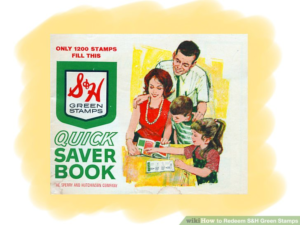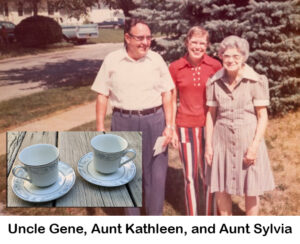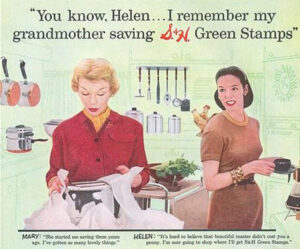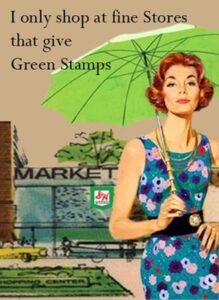 I discovered pasted-down Green Stamps in Grace’s bottom drawer when she passed away at 101. Seeing them transported me back to our kitchen table in Deerfield, Illinois. Young Elizabeth watched little brother Paul paste little blocks of perforated stamps in a newsprint book with a cover illustration of a happy family also pasting stamps. This time of year makes me think of fads gone by; before Amex gave you points and Delta gave you lounges, there were Green Stamps. Today you find Green Stamps online as GreenStampsForGood, called ‘S&H Interactive,’ with many of the same founding principles, with an added emphasis of support for local nonprofits. They aim to increase customer loyalty and motivate spending.
I discovered pasted-down Green Stamps in Grace’s bottom drawer when she passed away at 101. Seeing them transported me back to our kitchen table in Deerfield, Illinois. Young Elizabeth watched little brother Paul paste little blocks of perforated stamps in a newsprint book with a cover illustration of a happy family also pasting stamps. This time of year makes me think of fads gone by; before Amex gave you points and Delta gave you lounges, there were Green Stamps. Today you find Green Stamps online as GreenStampsForGood, called ‘S&H Interactive,’ with many of the same founding principles, with an added emphasis of support for local nonprofits. They aim to increase customer loyalty and motivate spending.
Those interested in the history of the ‘points redemption’ movement (frequent buyer/flyer etc.) in which many of us participate today, might know of the early adapters Sperry and Hutchinson Company. Green Stamps emerged as an innovation in 1896.
Here’s how it worked:
 You earned points for spending at places such as our town’s Deerfield Jewel Grocery Store; you picked up a little book to paste those stamps in, once pasted, you studied the S&H Catalogue, called the “Idea Book” for objects you wanted to “buy” with your stamps.
You earned points for spending at places such as our town’s Deerfield Jewel Grocery Store; you picked up a little book to paste those stamps in, once pasted, you studied the S&H Catalogue, called the “Idea Book” for objects you wanted to “buy” with your stamps.
This kept buyers returning to stores that offered those stamps, and rewarded buyers for paying at the point of sale. And for this a buyer picked out a “free” object from the Idea Book and exchanged for stamps collected. You claimed your object at one of 600 S&H Redemption Centers nationwide.
In the 1960s the Idea Book became one of the most consumed publications in the US, with 30 million households participating. The book held the record for the largest publication, winning out over published books in general. That Idea Book served as a wonderment to Paul and me. It seemed to offer everything, but nothing real kids really wanted. Mom DID redeem a few cool things from the Idea Book. And I have Aunt Kathleen’s pair of teacups sourced from Green Stamps ‘redemptions.’ In fact, in the history of the company, $10 billion in merchandise was “rewarded.”
Magic Marketing
 S&H sold stamps to retailers who in turn gave a buyer ten stamps for every dollar spent. Sperry and Hutchinson became pioneers in the spend to reward system, developing this concept in 1896. Green Stamps stood strong in the 1960s, when S&H printed three times as many stamps as the US Postal Service. Behind the brand stood Thomas Sperry of Cranford New Jersey and Shelly Byron Hutchinson of Ypsilanti, Michigan, who founded the firm that pioneered “rewards.” Mr. Sperry and Mr. Hutchinson ended up enemies as one of them grabbed the other’s stock in the 1940s but the company lived on.
S&H sold stamps to retailers who in turn gave a buyer ten stamps for every dollar spent. Sperry and Hutchinson became pioneers in the spend to reward system, developing this concept in 1896. Green Stamps stood strong in the 1960s, when S&H printed three times as many stamps as the US Postal Service. Behind the brand stood Thomas Sperry of Cranford New Jersey and Shelly Byron Hutchinson of Ypsilanti, Michigan, who founded the firm that pioneered “rewards.” Mr. Sperry and Mr. Hutchinson ended up enemies as one of them grabbed the other’s stock in the 1940s but the company lived on.
In the 1960s 85,000 merchants participated in this scheme. For every ten cents Mom spent at the grocery store, she received one point. If your mom were a big saver, like my mom, she “earned” those larger ten point or maybe even fifty-point individual stamps. These came in rectangles opposed to the square one-point stamps. One book held 12,000 points, and they gave other single books for just the ten and fifty point stamps. I still hear the crunch they made when you tried to bend the paper booklet of those pasted stamps.
Folks Post Green Stamps for Sale Online
 Collectors today might pay up to $1.20 for every 12,000 Green Stamps. Enticingly, the company that purchased Green Stamps, now called S&H Interactive, claims they’ll set up a program to redeem your old Green Stamps—the last redemption happened in 2001. Their website shows many smaller businesses in the “vintage” market buying those fondly remembered Green Stamps to hand out to nostalgic customers when they make a purchase.
Collectors today might pay up to $1.20 for every 12,000 Green Stamps. Enticingly, the company that purchased Green Stamps, now called S&H Interactive, claims they’ll set up a program to redeem your old Green Stamps—the last redemption happened in 2001. Their website shows many smaller businesses in the “vintage” market buying those fondly remembered Green Stamps to hand out to nostalgic customers when they make a purchase.
Back in the day, what did you buy with Green Stamps? The Idea Book catalog spanned upwards of 200 pages of anything from dish towels to ash trays, to fishing poles, to bikes, and some large items such as pianos. Courtney Cox (Friends) learned to play on the piano “won” by her mother.
 Other copycat companies found out how perfectly addictive the redemption game project became. For example, Piggly Wiggly grocery stores gave out their OWN stamps, with the same green color, called Greenbaks. Other trading stamps tried but never got as big as S&H: Plaid Stamps, Gold Bond, Blue Chip, and Best Value to name a few.
Other copycat companies found out how perfectly addictive the redemption game project became. For example, Piggly Wiggly grocery stores gave out their OWN stamps, with the same green color, called Greenbaks. Other trading stamps tried but never got as big as S&H: Plaid Stamps, Gold Bond, Blue Chip, and Best Value to name a few.
Today you cannot redeem S&H stamps for merchandise or money, but Sperry and Hutchinson, as of 2008, remained in business offering rewards for internet purchases called “Greenpoints.” (Clicks Instead of Licks). Everything comes around again and when Sperry and Hutchinson in 1999 instated the Greenpoints program, eight million enrolled. Imagine the fun if today we redeemed S&H stamps for brand new 1960s and 1970s objects, then walked back in time to a classic 1960s Redemption Center to pick stuff up in the old avocado green family station wagon.
A Great Story of the Power of Green Stamps
In 1966 a Pittsburgh school collected 5.4 million Green Stamps to buy a pair of gorillas; a male called Lonesome George for the Pittsburgh Zoo, and a female called Samatha for the Glenwood Park Zoo in Erie.